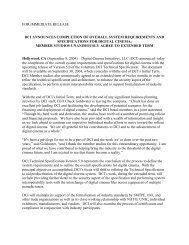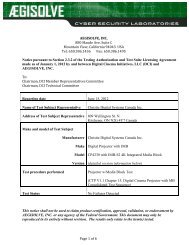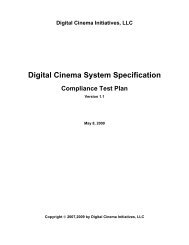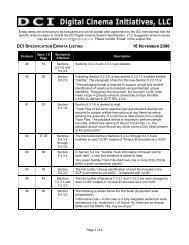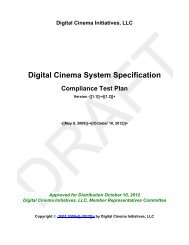DCI Specs - Digital Cinema Initiatives
DCI Specs - Digital Cinema Initiatives
DCI Specs - Digital Cinema Initiatives
You also want an ePaper? Increase the reach of your titles
YUMPU automatically turns print PDFs into web optimized ePapers that Google loves.
the LDB by the IMB SM (see Security Manager and LDB requirements of Section 9.4.3.5Functions of the Security Manager (SM) and Section 9.4.3.6.2.1 Normative Requirementsfor LD/LE SPB Devices) shall be performed to ensure that link keys are provided only tolegitimate devices which appear on the KDM Trusted Device List (see Section 9.6.2 “Trust”and the Trusted Device List (TDL)). Link Encryption keys shall be delivered to the LDB usingthe appropriate category 2 standardized security messages of Table 15 Intra-TheaterMessages Request-Response Pairs.In the case of playback of clear text content (as indicated by the CPL), no KDM is required,and in such a case no TDL will exist. Recognizing that combinations of clear text andencrypted content must be accommodated, the following rules define normative LinkEncryption functionality:• In any instance where content is not encrypted and no KDM for this content exists,the SM shall automatically assume “trust” in the LDB and projector SPBs forpurposes of keying the LDB and enabling playback for (only) that CPL. All loggingprocesses shall take place normally, recognizing that some logging events (e.g., nologging of content key use) will not be recorded.• In instances where combinations of encrypted and non-encrypted content constitutea Show Playlist, the SM shall require the LDB and projector to appear on the TDLprior to enabling keying Link Encryption functions and enabling playback for any CPLhaving encrypted content.It is encouraged that the industry standardizes the content encryption processing employedfor Link Encryption. However these specifications only dictate that such protection shallselect one of the TDES [FIPS (46-3) and ANSI standard X9.32] or AES algorithm applied ina NIST approved fashion. Link Encryption keys shall be 112 bits in length for TDES or 128bits in length for AES, and such keys shall be generated according to the requirements ofSection 9.7.6 Key Generation and DerivationIt is mandatory that a fresh Link Encryption key be used for each movie showing (i.e., eachplayout of an encrypted composition requires a new LE key.) Multiple Link Encryption keysmay be used for showings, and in such cases, it is encouraged that different LE keys bedistinguished by (used according to) the CPL (where different Composition Playlistsconstitute a showing). In the case where multiple LE keys are used, it will be necessary forthe industry to standardize on a single technique to identify which LE key is to be used forwhich portion(s) of any given showing.9.4.4.1. Multiple Link Encryption OperationContent owners may approve the use of multiple Link Encryption stages within a singleauditorium for accommodating special auditorium situations. Special auditoriumsituations are recognized as changes to Auditorium 2 of Figure 15: <strong>Digital</strong> <strong>Cinema</strong>Auditorium Security Implementations, such as: (i) the insertion of a single imageprocessor between Image Media Block and a LDB/projection system; (ii) the use ofmultiple LDB/projection systems with a single server/IMB.Multiple Link Encryption operation shall follow all normal (single) Link Encryptionrequirements of this section, with the following additional requirements:a. SM behavior shall be designed to identify a special auditorium situation duringthe auditorium security network TLS session establishment. The digital certificateexchange with remote SPBs will return the associated certificate roles for eachSPB in the auditorium (i.e., LD/LE SPB device or more than a singleLDB/projector).<strong>DCI</strong> <strong>Digital</strong> <strong>Cinema</strong> System Specification v.1.2 Page 119




